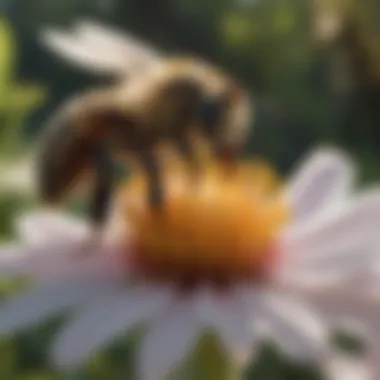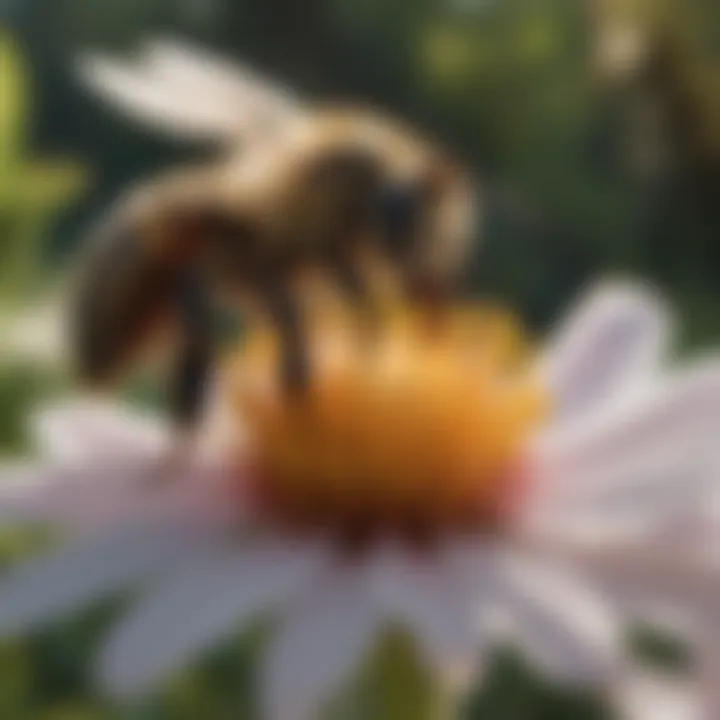Understanding Bees: Ecology, Importance & Conservation


Intro
Bees are often seen as mere insects buzzing around, yet their role is more profound than it appears. They are pivotal to various ecosystems, serving as primary pollinators for many plants. Understanding their ecological importance not only underscores their worth but also embodies a broader message about biodiversity and conservation efforts in our local environments.
In this article, we will delve into the presence of bees in different regions, their ecological significance, the challenges they currently face, and the necessary conservation measures we can adopt. Each section aims at providing insights into bee species, their habitats, and their essential interactions within woodland ecosystems.
Understanding Woodland Ecosystems
Woodland ecosystems are crucial for numerous reasons. They not only support diverse plant and animal life but also provide several ecosystem services beneficial to humanity.
Importance of Biodiversity in Forests
Biodiversity refers to the variety of life on Earth, encompassing various species and genetic differences. In forests, the presence of different plant species often leads to a healthier ecosystem. This diversity supports food webs, ensuring stability and resilience. Species such as bees contribute directly to this biodiversity by facilitating pollination, which is vital for the reproduction of many plants.
Role of Forests in Climate Regulation
Forests act as significant carbon sinks, absorbing carbon dioxide and influencing local climates. The presence of bees in these environments aids in maintaining and enhancing plant health and diversity, which in turn supports climate stability. Protecting bee populations can, therefore, have an indirect impact on climate regulation, emphasizing their importance in forestry practices.
"Healthy ecosystems foster resilient populations. Bees play an undeniable role in maintaining these ecosystems through their pollination activities."
Sustainable Forestry Practices
Sustainable forestry practices are integral to promoting biodiversity while allowing the continued use of forest resources. These methods ensure that forestry activities do not compromise the integrity of forest ecosystems.
Principles of Sustainable Forestry
- Minimal Impact: Reducing environmental harm during logging and resource extraction.
- Ecosystem Conservation: Maintaining the health of ecosystems while utilizing forest resources.
- Social and Economic Benefits: Balancing ecological goals with the needs of local communities.
Case Studies of Successful Implementations
Several regions and organizations have embraced sustainable forestry practices that benefit both bee populations and overall forest health. For example, certain logging companies have implemented selective logging processes that preserve bee habitats, allowing species to thrive while still meeting economic goals.
Woodland Stewardship Techniques
Managing woodland areas responsibly is crucial to ensuring the health of bee populations and preserving biodiversity.
Forest Management Plans
Effective forest management plans should include strategies that protect and foster bee habitats. This can involve the preservation of wildflower patches and the careful planning of tree populations.
Conservation Strategies
Several proactive strategies can be adopted to support bee conservation:
- Planting Native Flora: Encouraging growth of native plants that provide food sources for bees.
- Reducing Chemical Use: Minimizing pesticides and herbicides that can harm bee populations.
- Creating Pollinator Corridors: Designing landscapes that connect bee habitats, allowing for easier access to resources.
Prelude to Local Bees
Understanding local bees is a critical aspect when discussing ecological health and biodiversity. Bees play a fundamental role in pollination. This process is vital for the reproduction of many flowering plants, which in turn supports the entire ecosystem. The study of local bee populations helps us grasp these interactions, their societal roles, and the potential risks they face.
Significance of Pollinators
Pollinators, most notably bees, are indispensable to food production and ecosystem balance. They are responsible for pollinating over 80% of flowering plants. This includes a large percentage of crops we rely on for food. Consequently, their decline poses a significant threat to global food security. Understanding the significance of these pollinators in local ecosystems allows for better community awareness and promotes the necessity for conservation efforts.
Pollination leads to the production of fruits and seeds. This not only supports food chains but also contributes to the genetic diversity of plant species. Moreover, bees indirectly support habitats for other wildlife, enhancing overall biodiversity.
Overview of Bee Species
In any given region, one can find a diversity of bee species, each with unique behaviors and ecological roles. Common species include the Honey bee, which is well-known for honey production. Bumblebees are notable for their ability to pollinate in cooler weather. There are also solitary bees, which typically do not live in colonies but play significant roles in pollination nonetheless.
The diversity of bees is a reflection of the health of their environment. Local species can often provide insights into the ecological balance of the area. Moreover, understanding these species guides conservation practices tailored to specific needs of different bee populations.
"The future of food depends on pollinators. Through their daily work, bees significantly enhance crop production and stabilize ecosystems."
Bee Ecology


Understanding bee ecology provides critical insights into the relationships between these pollinators and their environments. Bees play an indispensable role in various ecosystems, enhancing biodiversity and supporting the health of plant populations. Diving into the ecological aspects of bees reveals the delicate balance they maintain within their habitats and emphasizes the necessity of their conservation.
Habitat and Nesting Sites
Bees thrive in diverse habitats, from urban areas to wildflower meadows. Each species has its own preferences for nesting sites which can be crucial for their survival. Honey bees, for example, often establish colonies in tree cavities or man-made hives. They are social insects that live in large colonies and rely on their environment for food and resources.
Bumblebees, on the other hand, prefer to nest in the ground, often in abandoned rodent holes or dense grass. Their ability to pollinate larger flowers in cooler temperatures makes them vital for many plant species, especially in northern climates. Solitary bees, which comprise the majority of bee species, exhibit a variety of nesting behaviors.
Some, like mason bees, use mud or resin to construct individual cells for their offspring. Others, such as leafcutter bees, collect pieces of leaves to create their nests. This variation in nesting behavior reflects the adaptability of bees to various ecological niches. Maintaining diverse habitats supports these nesting strategies and contributes to healthy bee populations.
Foraging Behaviors
Foraging behaviors in bees are complex and adapted to their specific needs. Bees primarily collect nectar and pollen from flowering plants. Nectar serves as an energy source, while pollen provides proteins and essential nutrients necessary for brood development. The foraging process is not random; bees exhibit preferences for certain flower types based on color, shape, and scent, which influence their efficiency.
Honey bees organize foraging activities through a system of communication. They perform a waggle dance, which conveys information about the distance and direction of food sources to fellow colony members. This form of communication ensures that optimal resources are utilized effectively. Bumblebees and solitary bees, while not as coordinated, also utilize scent markers to identify and revisit productive foraging sites.
In this way, bees foster mutualistic relationships with flowering plants, as pollination occurs alongside foraging. By transferring pollen as they move from flower to flower, bees facilitate the reproductive processes of numerous plant species, resulting in successful seed production.
Understanding these foraging behaviors is essential for appreciating the ecological roles bees play in sustaining plant communities and agricultural systems.
"Bees are not only essential for food crop pollination but also for a vast number of wild plants that contribute to our ecosystems."
Therefore, preserving their natural habitats and supporting their foraging activities through conscious land-use practices becomes a crucial step in ecological conservation.
Important Species of Bees
Understanding the various species of bees is crucial in appreciating their roles in our ecosystem and pollination processes. Different species exhibit unique behaviors, preferences, and interactions with local flora. This section highlights three important types of bees: honey bees, bumblebees, and solitary bees.
Honey Bees
Honey bees, specifically the Western honey bee (Apis mellifera), are well-known for their contributions to agriculture and food production. They live in large colonies, displaying complex social structures that include a queen, workers, and drones.
Their significance stems from their excellent foraging ability and efficiency in pollination. Honey bees not only pollinate a wide range of crops but also produce honey and beeswax, contributing to both natural ecosystems and agricultural economies. To illustrate their impact, studies indicate that about one-third of the food we consume relies on honey bee pollination, from fruits to nuts and vegetables.
However, honey bees face challenges such as habitat loss, pesticide exposure, and diseases, which threaten their populations. Protecting their habitats and promoting sustainable farming practices can ensure their survival and, consequently, the benefits they provide.
Bumblebees
Bumblebees are another essential group of bees, belonging to the genus Bombus. Unlike honey bees, bumblebees live in smaller colonies that usually consist of fewer than 100 individuals. They are notable for their ability to pollinate plants effectively, even in cooler temperatures.
Their larger bodies and hairy structure allow them to carry pollen efficiently from flower to flower. Many plants, especially those with tubular flowers, have evolved to rely on bumblebees for successful reproduction. The loss of bumblebee populations can destabilize these plant communities, reducing biodiversity.
Climate change and habitat degradation have critically affected bumblebee health. Conservation efforts focusing on maintaining wildflower habitats and reducing pesticide use are vital for their survival.
Solitary Bees
Solitary bees make up a diverse group, with thousands of species, such as mason bees and leafcutter bees. They do not form colonies like honey bees or bumblebees. Instead, each female typically nests alone and takes care of her own young. This behavior leads to varied nesting preferences, which can include burrowing in the ground or using existing tunnels in wood.
Despite their solitary nature, these bees are highly effective pollinators. They tend to be more efficient than honey bees for many wildflowers and crops. Many solitary bees have specific plant relationships, making them crucial for the biodiversity of local plants.
However, awareness of their importance is low compared to other bee species, leading to underappreciation of their ecological contributions. Protecting the habitats that support solitary bee populations is essential. Simple practices like leaving bare ground and avoiding excessive landscaping can help promote their well-being.
In summary, honey bees, bumblebees, and solitary bees all play vital roles in ecosystems and agriculture. Their different behaviors and nesting habits highlight the intricacies of bee populations and the necessity for targeted conservation efforts. By recognizing their contributions, we can better advocate for policies and practices that support their health and survival.
Bees and Woodland Ecosystems
Bees play a crucial role in the health and sustainability of woodland ecosystems. Their activities as pollinators significantly influence the composition and diversity of flora in forested areas. This section explores how bees contribute to the intricate dynamics of these ecosystems, particularly through the lens of biodiversity and forest health.
The Role of Bees in Biodiversity
Bees are essential for the reproduction of many plant species found in woodlands. By transferring pollen from flower to flower, bees facilitate the fertilization process that enables plants to produce seeds and fruits. This interaction is critical for maintaining genetic diversity among plant populations. A diverse plant community, in turn, supports a varied array of animal species that depend on these plants for food and habitat.


Some key points to consider regarding the role of bees in biodiversity include:
- Pollination Efficiency: Bees exhibit high efficiency in pollination, often returning to the same types of flowers, which enhances the potential for successful fertilization.
- Niche Creation: The variety of plants that bees pollinate creates distinct niches in woodlands. This fosters habitats for different organisms, thereby increasing overall ecosystem resilience.
- Agroforestry Benefits: In areas where agricultural practices intersect with wooded regions, bees aid in the pollination of crops that are often planted alongside native flora.
"The preservation of bee populations is directly connected to the stability of ecosystems and biodiversity across various habitats."
Maintaining healthy bee populations is thus not only vital for woodland plants but also for the broader web of life that depends on these habitats. Without bees, many plants would struggle to reproduce, leading to declines in plant diversity and, consequently, the species that rely on them.
Impact on Forest Health
Healthy bee populations are indicative of robust forest ecosystems. Their presence correlates with many factors that contribute to overall forest health. Bees help in maintaining the balance of these ecosystems by supporting various vegetation that may otherwise decline. Several aspects illustrate how bees impact forest health:
- Enhanced Resilience: Pollination by bees fosters a diverse range of plant species. Diverse plant life can better withstand diseases and environmental changes, leading to more resilient forests.
- Soil Quality Improvement: By promoting the growth of varied plant species, bees indirectly contribute to enhanced soil health. Plants' root systems stabilize the soil, prevent erosion, and improve nutrient cycling.
- Food Web Support: The fruits and seeds produced through bee pollination serve as food for numerous animals, sustaining different trophic levels within the forest food web.
Challenges Facing Bee Populations
Bees play a crucial role in our ecosystems, but they face significant challenges that threaten their existence. Understanding these challenges is important to appreciate the complexity of bee conservation. The factors affecting bee populations can also influence food production, biodiversity, and forest health. Addressing these issues is vital for ensuring the well-being of both bees and the environment.
Habitat Loss
Habitat loss is one of the leading factors contributing to the decline of bee populations. Urbanization, agricultural expansion, and deforestation have led to the fragmentation of natural habitats where bees reside.
- Urban Development: As cities grow, green spaces are being replaced with buildings and roads. This not only removes nesting sites but also disrupts the availability of food sources for bees.
- Agriculture Practices: Industrial farming practices often involve monocultures. Such practices reduce the diversity of flowering plants that bees rely on for nutrition. Additionally, the conversion of wild land into fields further diminishes bee habitats.
- Climate Effects: Changes in climate alter flower availability and blooming times. This can create mismatches in bees’ foraging habits.
Overall, protecting existing habitats and restoring lost ones are essential steps in safeguarding bee populations.
Pesticide Use
The use of pesticides in agricultural and gardening practices poses grave risks to bee health. Chemicals such as neonicotinoids are highly toxic to bees. When bees encounter these substances, whether through direct application or indirectly through contaminated pollen and nectar, their ability to forage and reproduce is compromised.
- Sub-lethal Effects: Even low levels of pesticide exposure can impair cognitive functions of bees. For example, bees may struggle to navigate back to their hives, reducing hive productivity.
- Pollinator Decline: The widespread use of harmful pesticides contributes to the overall decline in pollinators, leading to significant impacts on ecosystems and food production.
Efforts to promote pesticide-free alternatives can positively impact bee health and improve ecological balance.
Climate Change
Climate change presents numerous threats to bee populations, affecting their behavior, lifecycle, and habitat. Shifts in temperature and weather patterns lead to alterations in plant phenology.
- Changed Bloom Times: As temperatures rise, plants may bloom earlier. If bees do not adapt to these changes, they could miss critical foraging opportunities.
- Increased Weather Extremes: Climate change also leads to more unpredictable weather, affecting bee hive survival rates. For instance, extreme drought can limit food sources while heavy rains can destroy habitats.
- Range Shifts: Some bee species may be forced to migrate due to changing climates. However, not all species can adapt quickly enough or find suitable habitats to relocate.
Understanding the effects of climate change on bees is crucial for creating effective conservation strategies.
"The combined effects of habitat loss, pesticide use, and climate change create a multifaceted threat to bee populations that necessitates a coordinated conservation effort."
Conservation Efforts
Conservation efforts play a crucial role in the survival of bee populations and the overall health of our ecosystems. As bees are pivotal to pollination, efforts to protect them can have far-reaching effects on biodiversity, food production, and habitat stability. Understanding and implementing conservation strategies is essential for both individuals and communities. This section will outline important practices and initiatives that can help bolster bee populations in local areas.
Pollinator-Friendly Practices
Implementing pollinator-friendly practices is vital for creating a hospitable environment for bees. These practices extend from agricultural techniques to urban planning, and they encompass several key strategies:
- Reduce pesticide use: Pesticides, particularly neonicotinoids, have proven harmful to bee populations. Opting for organic farming or using environmentally friendly pest solutions can mitigate these risks.
- Plant diverse flora: Bees benefit from a variety of plants that bloom at different times of the year. Selecting native plants, wildflowers, and herbs can provide essential forage throughout the seasons.
- Establish bee habitats: Creating habitats through nesting sites, such as leaving bare patches of soil or building bee hotels, can encourage solitary bees to thrive in the area.
- Support local agriculture: Buying from local farms that adopt bee-friendly practices can contribute positively to local bee populations while boosting the local economy.
- Educate others: Raising awareness about the importance of bees and advocating for their protection in community meetings can lead to strategic action at a local level.
Taking these steps not only benefits bees but can also enhance local biodiversity and ecological resilience.
Community Initiatives
Community initiatives are instrumental in fostering a collaborative approach to bee conservation. Engaging individuals and organizations can lead to increased impact and sustainability. Here are some effective approaches:


- Establish local bee clubs: These clubs can provide a platform for enthusiasts and professionals alike to share knowledge, techniques, and resources related to beekeeping and pollinator conservation.
- Community garden projects: Setting up community gardens with a focus on pollinator-friendly plants can create valuable habitats. These spaces not only provide resources for bees but can also strengthen community ties.
- Educational workshops: Hosting workshops on the importance of bees and how to create pollinator-friendly environments can empower locals to take action in their own yards and gardens.
- Volunteer clean-up days: Organizing events to clean up local parks and green areas removes potential hazards for bees, like trash and pesticides, while engaging the community in conservation efforts.
- Advocate for policies: Communities can lobby for local laws that protect bee habitats, restrict harmful pesticide use, and support sustainable land use practices.
Community initiatives empower individuals and foster a collective responsibility towards conserving bee populations.
In summary, bee conservation is vital for ecological health and sustainability. By adopting pollinator-friendly practices and engaging in community initiatives, communities can protect and enhance bee populations effectively.
Beekeeping as a Form of Conservation
Beekeeping serves as an important mechanism in the conservation of bee populations. It provides numerous benefits that enhance local biodiversity and community awareness. As urbanization and agricultural practices continue to threaten natural habitats, beekeeping emerges as a practical solution for sustaining bee species vital for our ecosystems. Additionally, it fosters a connection between humans and nature, emphasizing the critical role bees play in our food systems and biodiversity.
Preamble to Beekeeping
Beekeeping, which is also known as apiculture, is the practice of maintaining and fostering bee colonies. This can be done for various purposes, including honey production and crop pollination. By encouraging local communities to participate in beekeeping, we can create a link between ecological health and food production. New beekeepers often start by learning basic techniques for hive management and bee biology. Resources such as local beekeeping associations can provide guidance and support.
The creation of bee gardens is often a part of starting beekeeping. These gardens include plants that provide nourishment for bees, which supports their populations. Moreover, maintaining hives offers a chance to study bee behavior and health, fostering greater understanding and appreciation of these insects.
Benefits of Local Beekeeping
Local beekeeping provides several benefits:
- Increase in Pollination: Beekeepers can significantly increase the pollination of nearby plants and crops. This directly contributes to higher yields and improved plant diversity in the area.
- Educational Impact: Beekeeping initiatives often lead to educational programs in schools and communities that raise awareness about the importance of bees. Knowledge sharing can inspire younger generations to value and protect local ecosystems.
- Sustainable Practices: It encourages sustainable agricultural practices among local farmers. By integrating beekeeping into their operations, farmers can reduce reliance on chemical pesticides, leading to healthier ecosystems.
- Economic Opportunities: The production of honey and other bee products can create economic opportunities for communities. This can enhance local economies and provide additional income for beekeepers.
- Conservation Stewardship: Engaging more people in beekeeping fosters a sense of stewardship towards the environment. Every beekeeper can contribute to conservation efforts simply by maintaining healthy hives and promoting biodiversity in their gardens and surroundings.
Beekeeping is not only about harvesting honey but also about understanding and supporting our local ecology.
Getting Involved
Engagement in local bee conservation is paramount. Bees are essential to pollination and thus to the health of our ecosystems. Individual actions can lead to collective efforts that significantly impact bee populations and their habitats. By getting involved, one not only enhances biodiversity but also fosters a greater understanding of local ecology.
Educational Resources
Education is the foundation for successful conservation. Various resources exist to enhance knowledge about bees and their environmental roles.
- Books and Publications: Literature such as "The Bees" by Stephen Buchmann offers insights into bee behavior and ecology.
- Online Courses: Websites like Coursera and FutureLearn provide courses on pollinator biology.
- Workshops and Seminars: Local universities and nature centers often hold events where experts share knowledge about bee conservation.
It is beneficial to follow organizations dedicated to bee research, such as the Xerces Society or Bee Conservation Trust. They offer newsletters and updates on ongoing projects, enhancing personal engagement and awareness.
Support Local Conservation Endeavors
Supporting local conservation initiatives is critical. Local organizations work on habitat restoration, education, and research efforts to bolster local bee populations. Here are effective ways to contribute:
- Volunteer: Participate in local clean-up days or habitat restoration projects organized by schools or non-profits.
- Donations: Financial support to organizations that focus on bee conservation enhances their capacity to create meaningful change.
- Advocacy: Engaging in community discussions about pesticide use and land use planning can influence local policies. Attend town hall meetings and express the importance of preserving natural habitats for bees.
Involvement in local conservation is not just beneficial for bees; it also enriches community ties. Working together towards a common goal leads to lasting results.
"Individual actions may seem small, but they are vital in the collective effort to sustain bee populations for future generations."
In summary, getting involved in bee conservation allows individuals to connect with their environment meaningfully. Protecting our pollinators requires community effort, education, and continuous support.
Culmination
The conclusion of this article serves to reaffirm the pivotal role bees occupy in maintaining ecological balance and promoting biodiversity. It emphasizes the direct relationship between healthy bee populations and thriving ecosystems. The importance of bees cannot be overstated; their pollination efforts are fundamental in supporting not only wild flora but also agricultural crops crucial for human sustenance.
The Future of Bees in My Area
The future of bees in local environments appears precarious. Several factors contribute to this uncertainty, including habitat degradation and climate fluctuations. Protecting and nurturing bee habitats is essential. Future conservation efforts must focus on restoring natural ecosystems that support diverse bee species.
Innovation in agricultural practices can also play a key part. Adopting integrated pest management strategies and reducing pesticide use will create a more sustainable environment. Trials in forage crops that provide consistent pollen and nectar sources could enhance food for bees. Moreover, community awareness and involvement are vital. Local schools, organizations, and governments should promote education about bee ecology, ensuring the next generations understand their importance.
Personal Responsibility in Conservation
Every individual has a role regarding conservation efforts for bees. Personal responsibility can manifest through various actions, such as creating bee-friendly gardens by planting native species that provide food. Avoiding harmful pesticides and supporting organic farming are also important steps.
Participating in local conservation initiatives can amplify these individual efforts. Engaging with local beekeepers or joining community groups focused on habitat restoration can foster a deeper connection to local ecosystems. By becoming informed advocates for bees and their habitats, individuals can contribute significantly to the larger conservation narrative.
"Conservation is a state of harmony between men and land." – Aldo Leopold
In summary, understanding the complex dynamics of bees in your area leads to informed choices that benefit both local ecology and global biodiversity. Continuing these discussions on conservation will sustain vital bee populations that play a crucial role in our world.







